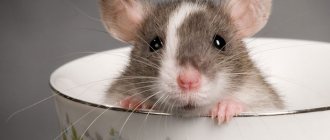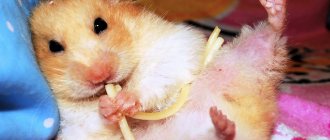- home
- Kinds
01.11.2018 Pets add variety to life and bring joy to children. The dwarf hamster does not take up much space in the house and is undemanding in care. It is enough to get to know the character of the rodent better, understand the principles of caring for it, and an entertaining miniature hamster will bring only pleasant emotions.
Varieties of dwarf hamsters
Proper handling and maintenance of dwarf hamsters requires knowledge of the characteristics and habits of each representative of this species.
The length of these animals does not exceed 50–70 mm, the average weight is 45 grams, and their life expectancy is about two years. Gentle pets need a caring attitude, but they are absolutely not problematic in terms of care and maintenance.
The most common representative is the Djungarian hamster, most often gray-brown in color, with a black stripe on the back. Taylor's dwarf hamsters are very similar to mice. The Campbell's hamster has a beautiful brown coat and a cheerful disposition. The Roborovsky hamster has a magnificent color, the fur on its back and head has a stunning sandy-golden hue, and its belly is white.
Each representative of dwarf hamsters has its own characteristics, but they are united by hyperactivity. This is a distinctive feature from its larger counterparts.
Albino hamster with red or black eyes
Such a handsome man can be of any breed.
And again we have to disappoint you - there is no separate breed of albinos with a specific eye color. Almost any living creature (even humans) can be born an albino.
Usually hamsters have black eyes, but albinos often have impaired eye pigmentation (this is the color on the inner surface of the eyeball). As a result, it becomes transparent and the red color we see is blood vessels.
An albino with any eye color is no different in caring for an ordinary animal of the same breed.
Djungarian hamster
Djungarians are funny rodents no more than 100 mm long and weighing up to 50 g. The animal has nice thick short fur. In nature, dzhungarikas have a gray-brown back with a bright black “ribbon” in the middle. The belly is always lighter, and the paws are white on the inside. Expressive eyes are black, convex and shiny, the muzzle is white.
Over the course of many years of selection of dwarfs with unusual deviations in color, the nurseries bred animals of interesting colors:
- tangerine almost red, but with the same stripe along the back;
- gray-blue, or sapphire;
- pearl without a characteristic stripe.
Dzungarik with a natural color is more resistant to disease. An animal with a mutation, an unusual color, very gentle and requires special care.
Red, or as they are also called, tangerine hamsters should not have joint offspring in order to avoid the birth of non-viable cubs.
Other types
Rodents called “long-tailed hamster” are sometimes found in pet stores and markets. With a body length of 10 centimeters, such animals also have a tail about 4 centimeters long. They have dark gray fur on the back, a light belly and a white edge near the ears.
Sometimes sellers try to sell an albino hamster as a separate breed. It is important to know that a representative of any species bred at home can have white fur and red eyes, and not just a “thoroughbred” specimen.
Sometimes, under the guise of a large hamster, expensive pet stores try to sell an animal such as a capybara, but this rodent has nothing to do with these rodents. In addition, just a cage for maintenance will not be enough; you will also have to equip a pond.
In the wild, mainly in the foothills of Tibet, the short-tailed hamster is found.
Taylor's Hamster
Taylor's dwarf hamster does not grow more than 80 mm. Because of its nice elongated muzzle and elongated body, it resembles a funny mouse. Beady eyes and tiny ears complete the fabulous picture.
The fur is fluffy and soft, the color is brownish-brown, the belly is white, and there is an elegant dark stripe on top.
Hamster lovers immediately buy a pair, and the animals get along well and breed. After 20 days of pregnancy, the female gives birth to three or even five cubs. She can have 10 offspring in a year.
In addition to its body structure, Taylor's hamster has another similarity with mice: the female and male tenderly care for their offspring.
Oral and dental diseases
Hamsters, like any rodents, grow their incisors throughout their lives, so owners should pay special attention to oral hygiene and the animals' teeth. If the pet does not grind down its teeth, this will lead to injury, damage to the oral mucosa, the development of acute inflammation, the formation of abscesses, and abscesses.
Pathologies and dental diseases in Djungarians and Syrians are manifested by redness of the mucous membranes, hypersalivation, decreased appetite, weight loss, abnormal growth, deformation of the incisors, and inflammation of the cheek pouches.
Inflammation of the cheek pouches is one of the most commonly diagnosed pathologies. It is characterized by inflammation, prolapse (prolapse), and the appearance of pathological formations. The disease develops due to injury to the oral mucosa. With this pathology, the animals behave restlessly, rubbing their cheeks and muzzle with their paws. Appetite decreases. Saliva flows from the mouth. As a rule, the pathological process affects the inner surface of the cheeks.
Long incisors provoke dental diseases in hamsters
To relieve inflammation, you need to rinse your pet’s mouth with an antiseptic solution or chamomile decoction. To normalize digestion, give your hamster probiotics and enzymes.
For neoplasms, surgical treatment, restorative, and symptomatic medications are prescribed.
If your hamster has inflamed cheek pouches, treatment should be carried out by a veterinarian. The specialist will carefully turn out the cheeks and clean them of food debris. Inflammation will be relieved by bactericidal drugs, antiseptics, and medications for local and general treatment. After therapy, the hamster must be kept on a fasting diet for 12–14 hours.
Campbell's hamster
The Campbell's hamster was once classified as a subspecies of the Dzungarik, but at the beginning of the 20th century it received its separate name from the British consul Charles Campbell, who brought amazing animals from the Russian-Chinese border.
Animals of both species are very similar to each other, but there are also significant differences:
- Campbells have slightly tousled fur, compared to the smooth, combed Djungarians;
- Campbells do not change color in winter, unlike dwarfs;
- the body has a “waist”, jungariki are egg-shaped.
Campbell's hamsters can be colored in the following colors: agouti, albino, opal, argenta, black, fawn, dove, blue, chocolate, lilac, blue spotted beige, platinum.
The main sign that this is a Campbell: unlike the friendly Djungarian, he does not like to sit on his hands and tries in every possible way to demonstrate his own independence. This is probably why Consul Charles Taylor liked the animal.
Bacterial and viral diseases of the hamster
Hamsters are very susceptible to diseases caused by pathogenic microorganisms, viruses, and bacteria. Infection is possible by contact, aerogenous, nutritional means, or by eating low-quality feed. Some diseases of bacterial etiology can be transmitted to hamsters from humans and other pets.
Colibacillosis
The infection is caused by Escherichia coli, which parasitizes the gastrointestinal tract of animals. This disease of dzhungarik is also known as “wet tail”, as the sore is manifested by severe diarrhea.
Other symptoms of colibacillosis include:
- decreased, lack of appetite;
- weight loss;
- restless behavior;
- depression, lethargy, apathy;
- drowsiness;
- the presence of wet fur near the anus.
Roborovsky's hamster
Roborovsky's hamsters are named after the Russian scientist who discovered and first described them. The homeland of the animal is China and Mongolia. But they are also found in Russia, for example, in the foothills of the Tien Shan.
Gradually, this animal won the hearts of lovers of miniature hamsters.
It is distinguished by its characteristic “bleached” eyebrows and fur-lined paw soles. Their eyes are always black. The color is most often a chic platinum color. There are variegated, snow-white, agouti, and cinnamon colors. In the wild, Roborov hamsters turn white in winter.
Breeders are attracted by the animal's high immunity to diseases. This is a distinctive feature of the Roborovsky hamster from its brothers.
Radde
The Radde breed (Dagestan or Cis-Caucasian hamster) is not often found in the homes of animal lovers. This rodent is more accustomed to the wild, lives in burrows and rarely emerges from its hiding places during daylight hours. It is not suitable for keeping at home, since it is often a carrier of various diseases that are dangerous both to other animals and to humans.
Radde's hamsters are one of the largest, some individuals grow up to 28 centimeters. As a rule, the coat of these rodents is brown interspersed with light and dark spots.
If a Radde hamster has already appeared in the house, then you will have to make every effort to tame it. However, any attempts to switch a nocturnal rodent to wakefulness during the daytime are fraught with negative consequences.
Care and choice of housing
The animals are extremely active, they need a large cage. You need to pay attention to the distance between the rods, which should not be more than 0.7 cm, otherwise the animal will run away.
Additionally, a running wheel, a small house for sleeping, labyrinths, and a sand bath are purchased.
Large sawdust or shavings are needed as filler, without dust, otherwise it will clog the animal’s airways. Do not use newspapers, as printing ink is poisonous to the hamster.
Hamsters are very clean. There is no need to bathe them, they will take care of themselves. But you need to clean the toilet as often as possible, otherwise an unpleasant odor will appear, and this is stressful for the pet.
It is very useful to let your hamster walk in a special walking ball. 15–20 minutes a day is enough to make a restless animal feel happy.
Today you can see two-level cages for hamsters on sale. Rodents, curious and nimble by nature, will definitely climb to the second floor. And then - depending on your luck. If they fall, there will be a tragedy. This must be taken into account when choosing a home for a miniature, delicate animal.
How to care for a hamster
To keep your pet healthy, you need to regularly clean its cage. Do this in the evening The ideal home for your hamster, when the animal is awake. Dispose of How to Clean a Hamster Cage stale food scraps from bowls every day. Pour clean water into the drinking bowl. Remove feces and wet areas of litter.
If your home looks clean, but it smells bad, you need to replace the filler completely. Sometimes rodents bury food in it, which eventually begins to rot.
Do general cleaning once a week. All you need is a sponge and a non-toxic disinfectant from a pet store. The latter can be replaced with mild hand soap: aggressive chemicals are poison for your pet. When everything is ready, remove the hamster from the cage and place it in a safe place. Don't forget to keep an eye on him. Thoroughly rinse the structure, bowls, running wheel and other accessories. Make sure everything is dry before putting it back in place.
Composition and nutritional standards
The dwarf hamster is an omnivore. But there is no need to abuse this quality to the detriment of the rodent and feed it everything that a person has on the table.
The basis of the menu for hamsters is seeds, cereals, greens, fruits and vegetables. Hamsters develop activity and appetite, so it is better at this time.
In the morning, it is enough to give him pieces of fruit, vegetables, corn, peas, and a dandelion leaf. In the evening, the diet can be supplemented with fish, chicken breast, cooked without salt and spices.
Your hamster should always have water. Remove spoiled food promptly, otherwise the animal will be poisoned. The animal should always have grains in its bowl, otherwise it will think that the cold weather is coming and it’s time to stock up for the winter.
You cannot offer your hamster citrus fruits, pomegranate, kiwi, cookies and candies, chocolate, watermelons, cabbage, milk, sausage, chips, hot crackers and other foods that will quickly damage the rodent’s gastrointestinal tract.
What to feed
Dwarfs have a high metabolism (metabolism), so they need more calories per gram of weight than their full-sized counterparts.
It is believed that the daily food intake is a tablespoon of grain feed. In any case, it is better to focus on the spot: each organism is an individual, the main thing is not to overfeed and avoid obesity. They feed twice a day.
Insects and twisted boiled meat (beef or chicken) are served as delicacies. The presence of animal protein in the diet of animals during pregnancy and feeding of offspring is especially important.
Don’t forget about liquid, which is necessary for any organism: the drinking bowl should always be filled with clean water at room temperature.
Hamsters' teeth are constantly growing, so it is vital for rodents to sharpen them. To prevent the baby from gnawing everything, a chalk stone, twigs, or even dog treats are placed in the cage. Neither has a negative effect on the dental or digestive system.
Features of reproduction
In order for the couple to be successful and fertile, hamsters are accustomed to each other from an early age. If you plan to breed hamsters, it is advisable to immediately take a pair. There is no need to experiment with different subspecies. Only cubs born from Dzungariks and Campbells are viable.
In captivity, rodents can bear offspring all year round. As soon as the female turns four months old, she is ready to bear offspring. An earlier pregnancy is undesirable; it can have a bad effect on the mother’s well-being. The female carries the cubs for 20 days. One litter can have up to 12 newborns.
The female needs to create favorable conditions. First of all, this is a diet rich in protein foods; in addition, buy a complex of vitamins. Before giving birth, you need to remove the male. Remove labyrinths and simulators, add more sawdust. The female will make a good nest for herself.
Bald, blind and deaf hamsters will acquire a “beautiful” appearance in just a week. After 15 days they will be feeding themselves. After 25–30 days, the cubs need to be “sorted” by gender and placed in cages.
You cannot pick up babies. The female may become angry, react aggressively to someone else's scent and show a tendency towards cannibalism. If the hamster falls out, it is picked up with a spoon, which is first dipped in the bedding.
Symptoms of diseases
How can you tell if your hamster is sick? This question interests many breeders of small pets. A healthy hamster has beautiful shiny fur, leads an active lifestyle, especially at night, and shows interest in the world around it. The animal eats food with appetite, makes supplies, and arranges its home. The Djungarian, the Syrian, has clear, clean eyes and an expressive gaze.
Important! You can understand that a rodent is sick not only by external signs, but also by the changed behavior of the hamster.
Main symptoms of diseases:
- decreased activity, lethargy, apathy;
- deterioration of fur condition (wet fur);
- severe itching;
- the appearance of scratches, bald patches, wounds, ulcers on the body;
- discharge from the nose, eyes;
- increased thirst;
- allergies, skin rash;
- bowel dysfunction (diarrhea, constipation);
- frequent urination;
- pallor, cyanosis of mucous membranes;
- sticky eyelids;
- the presence of blood and clots in the urine;
- disturbance of breathing, heart rhythm;
- accumulation of wax and dirt in the ears;
- yellowness, peeling of the skin;
- loss of cheek pouches;
- impaired coordination of movements;
- boils on the body.
In case of injuries or sprains, the hamster limps, sits constantly in the house or hides in the corner of the cage. The rodent loses a lot of weight or, on the contrary, gains weight and gains weight too quickly.
Ringworm in a hamster
Advice! Take a good look at your pet's home. If a hamster suffers from indigestion, cystitis, or endocrine pathologies, an unpleasant specific odor appears, the feces will be liquid, and the space will be filled with excrement.
If the hamster has lost weight, refuses its favorite treats, has watery eyes, swollen eyelids, the pet has become inactive, shows aggression, is breathing frequently, or other symptoms uncharacteristic of a healthy animal are noticeable, you should not ignore the problem.
If your dwarf or Syrian hamster is sick, do not self-medicate. If you discover that the rodent is sick, take it to the veterinary clinic or call a veterinarian at home. The choice of treatment methods depends on the root cause that provoked the soreness.
Prevention
Preventive measures cannot fully guarantee protection against cancer and other diseases, but the risk of disease is reduced many times over. To protect your cute animal, follow these rules:
- Clean the cage and wash it often, this will reduce the population of pathogens.
- Do not allow rodents to mate frequently if you have a married couple living with you. Remember that childbirth significantly undermines the body's defenses.
- Do not feed animals fatty foods.
- Take care of your animal's immunity. Fresh herbs and vegetables are great for this purpose.
Following these recommendations will have a good effect on the mood and health of the furry, prevent the occurrence of infectious diseases, and reduce the risk of tumors.
At the first symptoms of the disease, you should not self-medicate, but run to the doctor. Timely diagnosis and therapy will help cope with a number of diseases, but if your furry friend is diagnosed with cancer, you will have to come to terms with it.
The hamster's ears hurt. Causes
Hamsters very often suffer from various diseases. Their small size and fast metabolism contribute to rapid infection. And the spread of the disease. Hamster ears
quite often suffer from various diseases and parasites.
Most often, small rodents suffer from an ear disease such as otitis media. During this disease, inflammation occurs in the ears. This disease is quite serious and it is advisable to start treatment as quickly as possible.
This disease has quite a lot. Purulent discharge from the ear, unpleasant odor, sometimes hair loss. In this case, the hamster feels great discomfort and pain. Hamster scratching his ear
trying to get rid of the unpleasant itching inside the ear cavity. In this situation, you cannot do without human help.
You should not self-medicate. There are qualified specialists for this.
They will be able to make an accurate diagnosis and prescribe treatment. Often treatment consists of treating the ear. This can be saline solution or antibiotics, which can only be prescribed by a doctor. Self-treatment can lead to complications and further death of the animal. Since the ears are located close to the brain, inflammation can spread. Then your pet is doomed. It is recommended to treat diseases at the first stage. The symptoms are very obvious and appear immediately.
Infestation by ticks or other parasites is also quite common. Most often it is an ear mite. These are small parasites that live in the ear cavity. Transmitted from infected animals. They cause very severe itching, resulting in wounds. Treat with external treatments. Only a veterinarian can prescribe medication for you.
Neoplasms, tumors
Tumors (malignant, benign), pathological growths on the body, legs. ears is a fairly commonly diagnosed pathology in rodents, which can develop for a variety of reasons. Bumps can appear due to injuries, severe bruises, or falls from a height. To begin treatment, you need to establish a diagnosis, so take your pet to a veterinarian.
For benign and malignant tumors, surgical treatment will be prescribed. If the cancer is localized in a hard-to-reach area (oral cavity), or the tumor has metastasized, veterinarians recommend euthanizing the hamster, since no treatment method will give the desired result.
Growth on a hamster's ear
Only registered users have the ability to start new topics. Register and log in to the site by entering your username and password on the right side of the window, and you can start a new topic.
Before visiting the forum, read the topic: “How to properly consult a veterinarian,” as well as the list of answers to frequently asked questions, this will help you save your time and get an answer to your question faster. Pay special attention to the document: Symptoms of animal diseases. Perhaps in your situation you cannot expect an answer on the forum, but you need to urgently call a doctor or take the animal to a veterinary clinic!
Before joining the forum, read the following sections, this will help save your time and quickly get an answer to your question:
Attention! Pay special attention to the document “Symptoms of Animal Diseases”. Perhaps in your situation you cannot expect an answer on the forum, but you need to urgently call a doctor or take the animal to a veterinary clinic!
Source
Pros and cons of keeping a hamster at home
Before you get a pet hamster, you need to familiarize yourself with its main characteristics.
A convenient feature of this animal is that it is kept without a similar individual, that is, the hamster does not have to have a mate. He feels great alone, unless, of course, you are going to start breeding them.
The benefits of breeding a hamster at home are:
- small fluid intake, in case of taking juicy foods;
- keep the room quiet;
- the main difference from cats and dogs is the absence of rancor and resentment;
- have a positive attitude towards children;
- occupy a fairly small area;
- easy to train;
- breed in captivity;
- unpretentious in eating.
- in winter, the hamster can hibernate, and when it wakes up, it requires more food;
- constant care of the cage in which the animal is kept is necessary;
- It is necessary to keep a hamster only in a terrarium, otherwise it can ruin things;
- a hamster can be aggressive towards people.
Parasitic, fungal, dermatological diseases and symptoms
Hamsters, regardless of breed, often suffer from parasitic and fungal diseases. Djungarians are diagnosed with lichen, dermatophytosis, and trichomoniasis. The main manifestations of mycoses are severe itching, restlessness, deterioration of the coat, the appearance of rashes on the body, scratching, wounds, and long-term non-healing ulcers. With dermatophytosis, the skin acquires a yellowish tint and is very flaky. If treatment is not started, pathogenic flora penetrates into wounds and scratches, which provokes inflammation in various structures of the dermis.
Wet eczema in a hamster
Important! If a hamster is sick with a parasitic or fungal disease and is kept in the same cage with other rodents, immediately isolate the sick animal and disinfect the pet’s home.
Hamsters are susceptible to dermatitis, dermatoses of various etiologies, as well as allergies. Deterioration in the condition of the coat, partial or complete baldness is provoked by frequent stress, deficiency of vitamins, minerals, external parasites, fungi, and substances of a toxic nature.
Your veterinarian will tell you how to treat mycoses. The pet will be prescribed fungicidal, antibacterial agents, solutions (Miramistin, Chlorhexidine), as well as antiparasitic shampoos.
Unpopular breeds or wild hamsters
Most wild hamsters are nocturnal and go into short-term hibernation in winter. They feed on both plant and animal foods, preferring products from their habitat. Many of them build holes, breaking through long labyrinths; small individuals use other people's homes.
Common hamster (karbysh)
A wild hamster can reach a size of 34 cm, and the length of its tail is 3-8 cm. It lives in steppes and forest-steppes, often settling near humans. Its skin is bright: the back is reddish-brown, and the belly is black. There are white spots on the sides and front. There are black specimens and black ones with white spots. Karbysh live in the wild for 4 years, and in favorable conditions they can reach 6 years.
Common hamster
Gray hamster
The gray hamster is a rodent, no larger than a mouse. it belongs to the genus of gray hamsters. The body length is from 9.5 to 13 cm. It has a gray back and a light belly. Depending on the habitat, the color of the skin may change. He doesn’t dig holes himself, but takes other people’s. The animal has large cheek pouches and small ears. In some regions it is listed in the Red Book.
Gray hamster
Hamster Radde
The Radde hamster is found in the foothills and mountainous areas and prefers plant foods. It multiplies rapidly and destroys the grass, which angers farmers. The animal reaches a size of 28 cm and weighs more than 700 g. There are individuals weighing about 1 kg. The rodent's skin is silky: brown on top and dark below with reddish “inserts”. There are white spots along the face and behind the ears. In the wild, the animal lives for about 3 years.
Hamster Radde
Eversmann's hamster and Mongolian hamster
The genus of Eversmann's hamsters includes two rodents that are similar in appearance and habits: Mongolian and Eversmann. Both animals prefer steppes and semi-deserts. The Mongolian lives in the deserts of the country, northern China and Tuva.
Mongolian hamster
Both animals are no more than 16 cm in size with a short tail of 2 cm. The Mongolian is slightly smaller, the color of its back is lighter and there is no characteristic dark spot on the chest, like the Eversmann hamster. The Eversmann hamster may have an intensely colored back, brown, black or golden. Both hamsters have a light belly and legs. They are listed in the Red Book.
Eversman's hamster
Barabinsky hamster
The animal belongs to the genus of gray hamsters. Lives in Western Siberia, Transbaikalia, Mongolia. The body length is up to 12-13 cm, the tail is about 3 cm. The rodent is dressed in a red fur coat and there is a black stripe along the back: from clear to blurred in different individuals. The abdomen is light to white. A characteristic feature is two-color ears with a white border along the edges. There are 4 types of hamsters.
Barabinsky hamster
Daurian hamster
The Daurian hamster is a variety of the Barabensis (Cricetulus barabensis Pallas). Lives in Western Siberia. The color of the back is darker than that of other subspecies. A clear stripe is noticeable on the back.
Daurian hamster
Brandt's hamster
Belongs to the genus of medium-sized hamsters. The size of the individual is from 15 to 18 cm, the tail length is 2-3 cm, it weighs 300 g. It lives in the foothill steppes of Transcaucasia, Turkey and Lebanon. The color of the back is brown, the belly is white or gray. The animal has a dark spot on its chest. There is a double white stripe running along the neck around the head, which starts from the mouth and ends near the ears. There are light spots on the cheeks. Lives for about 2 years.
Brandt's hamster
Hamster Sokolov
Little-studied representatives of the genus of gray hamsters. They live in Mongolia and China. Unlike many other members of the family, they do not harm cereal crops. The size of the animal is about 11.5 mm. He has a gray skin and a light belly. The hamster's tail is almost invisible. There is a dark stripe along the back. It will not live long in captivity because there is too little information about it.
Hamster Sokolov
Chinese hamster
The Chinese hamster is named after its habitat. It belongs to the genus of gray hamsters. This is an animal with a slightly elongated body - 8-12 cm and a bare tail. The back of the animal is dark brown with a noticeable stripe. Rodents live on average 2.5 years.
Chinese hamster
Newton's hamster
A bit similar to the “Syrian”, but different in color and character. If the former are peaceful, then “Newton” has an evil disposition. Its size is up to 17 cm, its tail length is up to 2.5 cm. The rodent has gray-brown fur on the back with a black stripe from the head to the middle of the body. The throat and part of the chest are covered with dark fur, and the belly is light.
Newton's hamster
Taylor's Hamster
These hamsters grow no more than 8 cm. Their back is gray-brown and their abdomen is light. They live in Mexico and Arizona. In nature, they use other people's holes or make houses near stones and crevices. They live in dense grass.
grasshopper hamster
The grasshopper or scorpion hamster lives in Canada and Mexico. It grows up to 14 cm, including the tail, its weight is 40-60 g. Its skin is brown, its abdomen is light. The animal feeds only on insects, lizards and small rodents. Species of hamsters like this predator are no longer found. A scorpion can also become its prey. The hamster is resistant to insect venom. These hamsters sometimes squeak for a few seconds while raising their head up. This phenomenon is commonly called the howling of hamsters.
grasshopper hamster
Siberian hamster
The Siberian hamster is distinguished by a seasonal change of coat. This dwarf member of the family wears a dark gray outfit with a brown stripe in summer, and in winter he dresses in a white fur coat with a gray line on the back. The animals grow up to 10 cm, and the maximum weight when kept at home is 50 g. In nature, rodents live 2.5 years, in captivity - up to 3 years.
Siberian hamster
Tibetan hamster
Dwarf Tibetan hamsters live in China. These types of hamsters can live in mountainous areas at altitudes of up to 4000 m above sea level. The animals grow up to 11 cm, with the tail making up almost half the body length. Their color is gray with dark and black veins. The tail is pubescent and has a black stripe running along its surface. The abdomen and underside of the tail are light.
rat hamster
These agricultural pests live in Northern China. The size of the animals is up to 25 cm, the tail grows up to 10 cm. The color of the back is gray-brown, the abdomen is light, the tail is brown, the paws are white, the soles are covered with hair.
rat hamster
Short-tailed hamster
This breed of hamster lives in Tibet and China at an altitude of 4000-5000 m above sea level. Their color is uniform: brown, gray with a yellow tint. With a body length of up to 10 cm, they weigh 40 g.
Canese hamster
A little-studied species. Lives in deciduous forests of China. It feeds on plants and builds nests on the ground. The length of the animal is 17 cm, the tail is 10 cm. The rodent has dense fur, and white claws are visible on its thin paws. The color of the back is gray, there are white spots on the ears and cheeks, and the belly is also white.
Pet hamster diet
If you still decide to get a pet, you need to know what a hamster eats several times a day. Since this animal is active at night, select the most high-calorie foods for its evening meal. To avoid poisoning, do not feed him excessively watery food (watermelon, melon, cucumber, etc.).
Approximately once a day you need to give your pet a special food made from a mixture of grains, the range of which is offered by specialized pet stores for animals.
The hamster usually determines the norm for one meal without anyone's help, but food must be constantly present, as well as the presence of fresh water. Don't forget to make sure your pet drinks enough throughout the day, this is a vital condition for hamsters!
Approximate diet for a domestic hamster:
- Vegetables and fruits, pitted.
- Potato.
- Grain mixture.
- Lean cooked meat.
- Seeds and nuts in small portions.
- Vitamin complex.
It is highly undesirable to feed your animal garlic and onions, citrus fruits and tropical foods.











